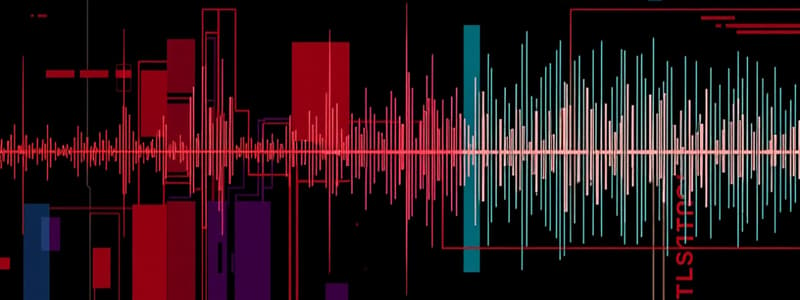Podcast
Questions and Answers
The quantization process converts discrete signals into continuous waveforms.
The quantization process converts discrete signals into continuous waveforms.
False (B)
Pulse code modulation (PCM) is a form of analog modulation.
Pulse code modulation (PCM) is a form of analog modulation.
False (B)
As a signal travels through a medium, attenuation decreases while noise levels remain constant.
As a signal travels through a medium, attenuation decreases while noise levels remain constant.
False (B)
Sampling theory is used to convert analog amplitudes into discrete levels during the digitization process.
Sampling theory is used to convert analog amplitudes into discrete levels during the digitization process.
Man-made noise is solely produced by natural atmospheric phenomena and has no connection to human activities.
Man-made noise is solely produced by natural atmospheric phenomena and has no connection to human activities.
The quantization process in analog-to-digital conversion involves converting continuous signals into discrete values.
The quantization process in analog-to-digital conversion involves converting continuous signals into discrete values.
A signal-to-noise ratio that is higher indicates a poorer quality signal.
A signal-to-noise ratio that is higher indicates a poorer quality signal.
In sampling theory, a sampling frequency must be at least twice the highest frequency contained in the analog signal to avoid aliasing.
In sampling theory, a sampling frequency must be at least twice the highest frequency contained in the analog signal to avoid aliasing.
Channel impairments do not affect the transmitted signal in amplitude modulation.
Channel impairments do not affect the transmitted signal in amplitude modulation.
Phase modulation is a technique where the frequency of a carrier signal is varied to transmit data.
Phase modulation is a technique where the frequency of a carrier signal is varied to transmit data.
Flashcards are hidden until you start studying
Study Notes
Sampling and Quantization
- ADC (Analog-to-Digital Converter) transforms analog signals into digital (binary) equivalents.
- Sampling processes convert analog amplitudes into discrete levels, utilizing pulse amplitude modulation (PAM).
- Quantization approximates pulse amplitude values to the nearest integer within a predefined set.
- PCM (Pulse Code Modulation) encodes quantized signals into binary, representing discrete signals as highs (1) and lows (0).
- Line coding transforms digital data into digital signals in waveform format for transmission.
Channel Impairments
- Attenuation: Signal strength diminishes over distance within a transmission medium.
- Noise: Unwanted signals superimposed on desired signals, classified as:
- Atmospheric noise: Caused by natural phenomena (e.g., thunderstorms).
- Man-made noise: Arises from human activities and electrical devices.
- Extraterrestrial noise: Originates outside the Earth (e.g., solar and cosmic noise).
Light Frequency Calculation
- Frequency of violet light (λ = 400 nm) calculated using the formula:
- f = c/λ where c = 3 × 10^8 m/s results in approximately 7.5 × 10^14 Hz.
Modulation and Modems
- "Modem" combines "modulator" and "demodulator" functions for converting data to signals and vice versa.
- Modulation processes include:
- Amplitude Modulation (AM): Varies carrier amplitude according to the analog baseband signal.
- Frequency Modulation (FM): Varies carrier frequency based on the analog baseband signal.
- Phase Modulation (PM): Alters carrier phase in relation to the analog baseband signal.
Data and Signals
- Data must convert into electromagnetic signals classified as analog or digital:
- Analog signals: Infinite values, represented as sine waves (e.g., speech, audio).
- Digital signals: Binary values (0 and 1), represented as square waves.
Signal Characteristics
- Periodic Signals: Complete a pattern in a measurable time frame and repeat it (one full cycle).
- Nonperiodic Signals: Change without a repeating pattern.
Signal Terminologies
- Wavelength (λ): Related to frequency (f) via the formula λ = c/f, with c being the speed of light (m/s).
- Frequency (f): Defined by the number of waves passing a point per time period, expressed in hertz (Hz), with the formula f = 1/T.
- Amplitude: Measures wave size from the equilibrium point to crest or trough extremes.
Studying That Suits You
Use AI to generate personalized quizzes and flashcards to suit your learning preferences.



